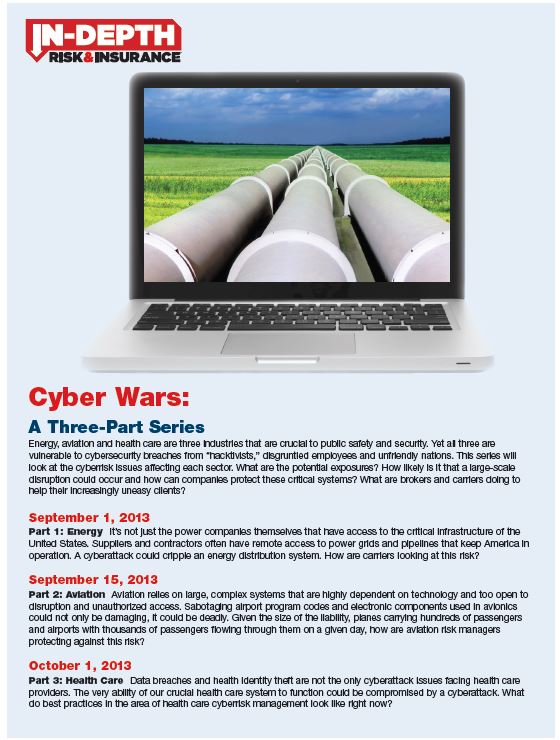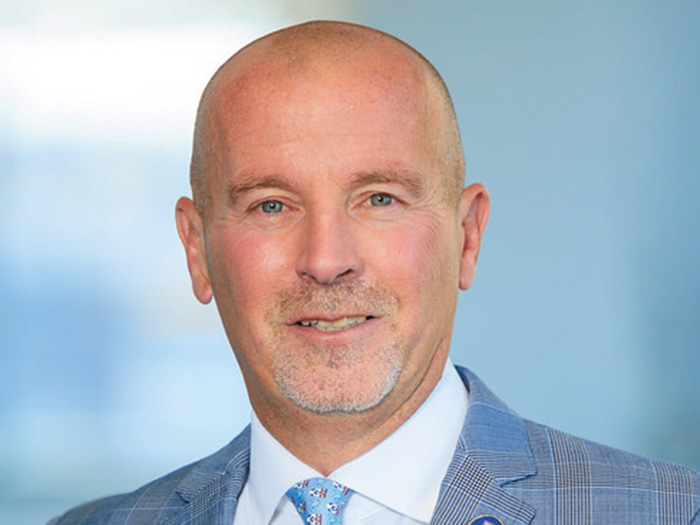Cyber Risks
Fueling Cybersecurity

With cybercrime now top of mind for many, the executive branch of the federal government is laying the groundwork to address cybersecurity at a national level. Under a series of target dates set in an executive order signed by President Barack Obama on Feb. 12, several departments and agencies are compiling lists of “critical infrastructure at greatest risk,” and enlisting the private sector’s help.
While the energy sector is not named specifically in the order, risk-management professionals said the sector — from oil and gas wells through pipelines and processing plants to refineries, fuel distribution, and petrochemicals — is at the top of the draft lists of critical infrastructure to be protected.
And there is much to be done to defend energy resources from hackers, said industry experts.
It might seem that a refinery or pipeline would be a self-contained, secure operation, but in reality “most of the energy complex is connected to the Internet,” said Jody Westby, CEO of Global Cyber Risk.
“That includes data systems and control systems,” she said. “Refineries manage their crude-oil inputs, their processing and their shipments through distribution systems that are on the Internet. They do not operate anymore on stand-alone dedicated systems.”
Westby said that “there is always the risk that some exposure can come through those connections and involve critical data or operations. The risk profile of the energy sector has changed substantially in recent years. At the same time, the sophistication of these threats has risen exponentially.”
Social Media Risk
The threats and exposures are many and varied. They range from a single rogue employee to organized crime to terrorists to spying by other nations. The threats can be theft of confidential personal data or proprietary competitive information, to malicious acts causing loss of data or actual disruption of operations. For the energy industry, which handles hazardous materials, a hacking event that leads to a spill becomes more than just a bad day at the office.
Use of the web by employees for personal recreation is an area where energy risk managers concerned about cyberrisk should also be paying attention.
“Energy companies do not think of themselves as big users of social media,” said Westby, “but their employees are, and they tend to have employees in some very sensitive areas of the world.”
Security breaches can happen by accident or ignorance, she added, not just by deliberate attacks.
“I have one energy client that conducted an online search as part of an exposure assessment and found critical plans for some of its facilities out there on the Internet.”
So far, energy companies do not have a good reputation for their ability to defend against cyberattacks.
GCR conducts a corporate cybersecurity governance report every other year, in collaboration with the CyLab at Carnegie Mellon University in Pittsburgh, and Westby noted that “in every area, energy and utility companies rank last or near last.”
According to the latest report, from 2012, “Energy/utilities respondents also ranked the lowest in establishing board risk committees separate from the audit committee, but indicated that when they do form a risk committee, they assign it responsibility for privacy and security. Only half of the energy/utilities and infrastructure sectors indicated that they have cross-organizational committees.”
Research toward the next report is already underway. That report will be issued in May 2014.
In addition to the report, GCR collaborates with Dempsey Partners, just recently acquired by Aon, in cyber evaluation and risk quantification (CERQ).
Dempsey is an accounting firm that specializes in pre-loss quantification to be used in planning, such as for business continuity, contingency and risk transfer.
“Energy companies have quite compelling cyberrisk exposures,” said John D. Dempsey, the firm’s managing director and practice leader for Property Claims and Valuation at Aon Global Risk Consulting.
“The risks are changing and the threats are multiplying. Energy companies do have vulnerabilities and lapses in security. They know this,” he said. “What they don’t know is what the actual damages of a breach or loss could be. We try to figure that in advance, so they can better determine which exposures to address in what order.”
The most obvious ones may not be the most damaging ones, and the potential costlier ones may not be the most difficult to rectify.
“Insureds are out there buying limits and they don’t really know if that is enough or too little or too much,” said Dempsey. “One thing for sure is that the more any system is dependent on process, the more they represent a vulnerability.
“For example, an oil company selling fuel may not think of itself as such, but it is a consumer products company gathering personal and financial information. It has an obligation to keep that data secure,” he said.
Beyond the material threats and responses, there is also a meta-risk in the fluid nature of the existing insurance coverage, warned Greg Gamble, director with Crystal & Co., with responsibility for management and professional risk.
“When coverage of cyberrisks was first introduced, all the carriers had different names and terms and conditions,” he said, “but that is now rapidly being standardized. The key insuring clauses often had sublimits, and we are seeing those increased every quarter or six months.”
Personal Injury a Gray Area
That said, there are still gray areas.
“The market has been slow to extend bodily injury coverage to those caused by electronic perils. If a pipeline or refinery gets hacked, and that causes a spill or fire, there will have to be some sorting out,” he said. “Property causes are very specific and are only triggered by covered perils such as wind or fire.
“If the proximate cause is software failure or a network breach, at this moment we are definitely talking about litigation to resolve. Property insurers will have to recognize that those should be covered, but they are moving very slowly. At this point no one has wrestled with this in the real world,” he said.
Currently Crystal’s work with customers has been more tactical.
“We have spent a lot of time focused on contracting practices with outside vendors and third parties,” said Gamble.
“We review contracts as they pertain to data hosting and cloud-based software to evaluate indemnification and hold-harmless agreements. We try to make sure all parties are holding up their responsibilities.”
Part of the challenge, Gamble noted, is that “risk-transfer tools, policies and practices have been around for a very long time. The risk management professionals at insureds know their coverages, but they need to know how the coverages they have will protect them from these new perils. That is why we involve those risk management officials in the process early.
“There has to be a healthy dialogue,” he explained, because sometimes the risks are from the outside in, others from the inside out.
In an effort to get a handle on the many different manifestations of cyberrisk to the energy industry, ACE divides them into two groups, said Michael Tanenbaum, senior vice president of ACE Professional Risk.
“The first is very similar to retail. It is uniquely identifiable information and other customer records. There are state laws mandating notification if a breach occurs, and consequences for making whole those affected by the breach.” The other group involves energy companies seeking coverage for business interruption coverage for extra expense and lost revenue arising out of a network attack.
For data breaches, ACE has response resources for insureds, Tanenbaum said.
“We have a data-breach team that is led by a coach, which is an independent law firm. The first step in any breach is to contact counsel, so the attorney-client privilege resides with them. The second is a team of service providers with specific areas of expertise: call centers, data monitoring, forensics, ID restoration and public relations among them. We really try to avoid one-stop shops. Not every firm skilled in forensics is also an expert in setting up a call center.”
Tanenbaum stressed that the selection process for the service providers is robust, including financial solvency and performance history.
For all that emergency-response capability, the best risk management is risk prevention.
“We work with a firm to conduct risk assessments with our clients to determine their vulnerabilities and what possible mitigations there may be,” said Tanenbaum.
“We also insist that there is a dedicated team within the client company that can assess risks and handle breaches. That includes a member of the C-suite, as well as legal, information technology, communications and operations.”
Circling back to the president’s executive order, Toby Merrill, a vice president with ACE Professional Risk, noted that once critical infrastructure is designated, and the threats are assessed, a standard similar to the “reasonable standard of care,” in health care is likely to result.
“That will raise the bar for cyberrisks in energy and other critical industries,” he said. “The playbook is being written as we speak. There will be more defined responsibilities, and failure to deliver on those standards will affect liability.”
Summarizing, Merrill noted that the grouping of risks into retail and operational is overlaid with insurance conventions of first- and third-party exposures. “There is a trend within the traditional lines of insurance to insert more privacy and network security exclusions in those policies. So insureds and brokers need to determine what perils are listed and if they address cyber issues with a stand-alone policy. If there is an infrastructure exclusion, that would need to be modified or addressed, both first-party and third-party, to cover an instance where a hacker were to access a network and disrupt data or operations.”












